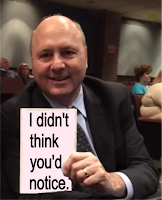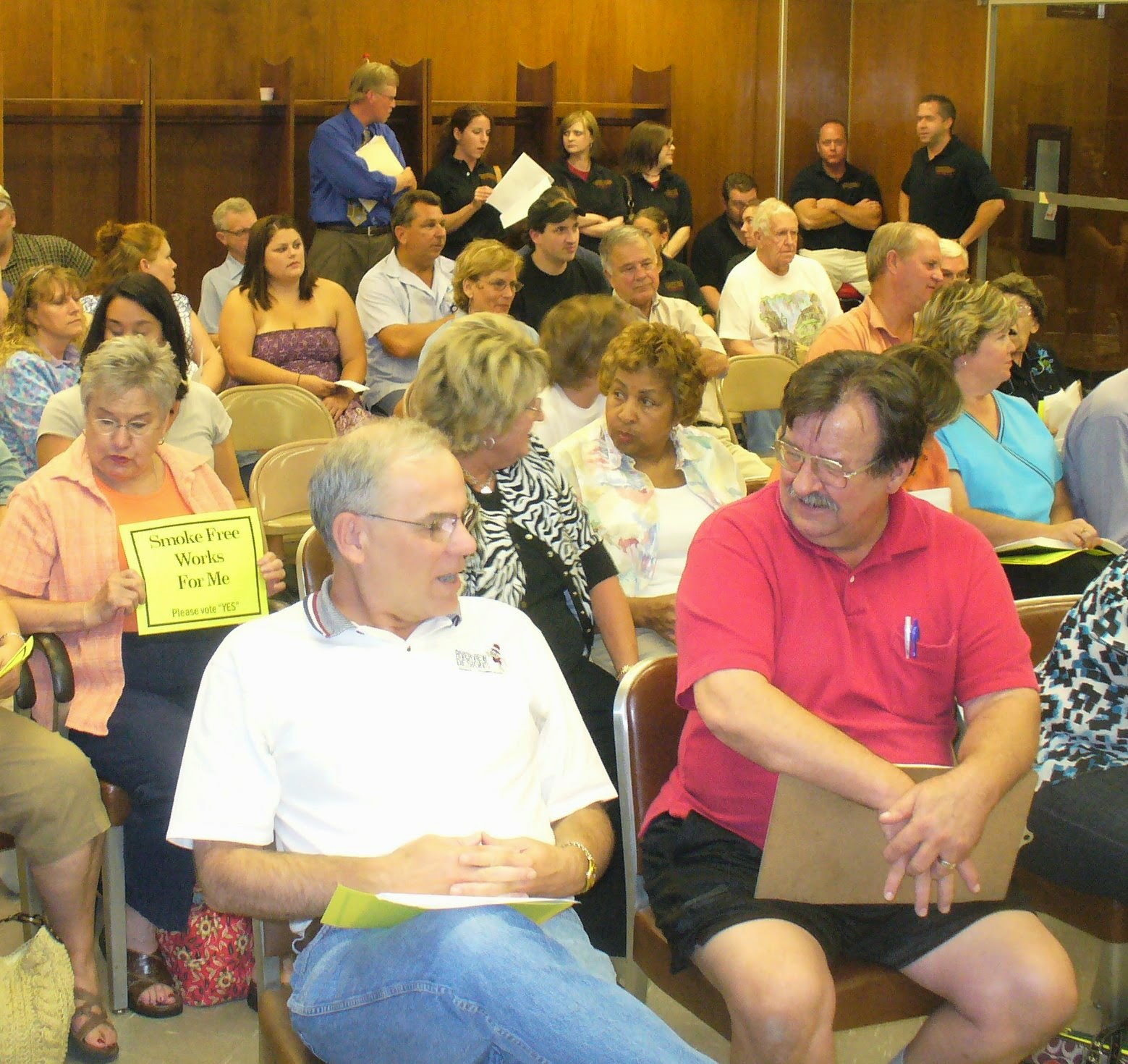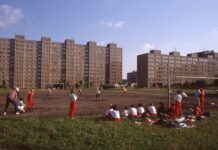
Rest assured, it remains my goal to phase out the strident polemics — I am, and I will, but as H. L. Mencken is my witness, I simply refuse to allow both City Hall and the News and Tribune to cooperate on shameless diversions when people literally are dying on city streets owing to Jeff Gahan’s casual indifference.
Progressives, where are you? “What you permit, you promote. What you allow, you encourage. What you condone, you own.”
Article Synopsis: Mayor Jeff Gahan’s announcement of a future rails-to-trails pathway from New Albany to Bedford is all hat, no cattle. For one thing, when’s the last time he’s been spotted walking? Most of the right-of-way lies outside of New Albany; the path should be multi-modal and not only for walkers; and all of the work (if any occurs) will take place over a period of decades. This breathless announcement is another politically-motivated diversion, intended to impress casual observers with surface sheen, even as the mayor refuses to undertake common-sense traffic-calming measures to render his own city’s street grid safe for non-automotive users.
Grade: D … partial credit awarded for artfully stealing ideas from others
—
A guy riding a bicycle is struck by another guy driving a truck. The bicyclist dies, the driver says it wasn’t his fault, civil authorities breathe a sigh of relief because they needn’t give a damn (yet again), and life goes on.
Except, of course, for the bicyclist — who never once had the chance to tell his side of the story.
How many bicyclists, skateboarders and pedestrians have to die before Jeff Gahan gives a flying fuck?
The News and Tribune scarcely notices any of it, burying news of the bicyclist’s death beneath a sculpture installation and Democratic Party chairman Adam Dickey’s most recent petty, formal complaint about behavior on the part of the opposing political party, to whom Dickey routinely loses elections but somehow manages to retain his position.

And, in a marvel of poor timing, Jeff Gahan chooses to occasion of another death on his city’s streets to take full credit for seizing an opportunity to create a rails-to-trails project that doesn’t yet exist in any tangible form, will require decades for construction and untold millions of dollars to achieve, the bulk of responsibility to be shouldered by entities other than Gahan’s own TIFFed-out New Albany municipal government.
It gets even worse. Bob Caesar, himself a slobbering mayoral aspirant, gets downright servile.
“I think it’s an exciting thing,” New Albany City Councilman Bob Caesar said at Monday’s council meeting. “It’s a big deal for New Albany. This can be a big shot in the arm.”
In short, it’s another day in Jeff Gahan’s luxury-driven, quality-of-life (for people with money) paradise, and instead of asking myriad questions about why normal folks who haven’t taken the precaution of arming themselves with automobiles keep losing their lives in downtown New Albany, the newspaper goes all in on adoration for Gahan’s pastoral fantasies about building this rails-to-trails connection to Bedford, a city that the mayor tells Chris Morris might as well be Bloomington, even though a whole 25 miles separate the two cities.
The city’s triumphant video about a non-existent trail system that apparently won’t even touch downtown New Albany or link with the Greenway (itself 30 years in the making) was released on the same day that our car-centric street grid claimed another victim, and also at roughly the same hour as David White announced his candidacy for mayor in opposition to Gahan.
Think there might have been a connection?
As we’ve observed so many times in the past, whenever the cognitive dissonance becomes too much for Bud Light to handle, the mayor pops up to hoist a pleasant artist’s rendition of the latest bright shiny object:

No, not that one. Maybe this one:

As for the video itself, Gahan wants us to believe he’s in possession of critical knowledge of the sort that only he knows and can deploy for health and recreational benefits.

Little-known? Maybe to Gahan, until someone like Scott Wood told him.
Of course, there have been hundreds of Rails to Trails projects in America over the past 30-odd years.
Rails-to-Trails Conservancy is a nonprofit organization dedicated to creating a nationwide network of trails from former rail lines and connecting corridors to build healthier places for healthier people.
The single best way to prove that “rails-to-trails” is a familiar concept nationwide is that lawyers often litigate it.
People Love (to Sue) Rails-to-Trails Projects, by Eric Jaffe (CityLab)
The federal government has paid $49 million in claims in the past year alone.
Rails-to-trails projects — old railroad corridors re-purposed for hiking and biking — have exploded in popularity in recent years. Many of the 1,800 rail-trails that now exist across the United States run through remote areas, but there are lots that go through cities, too. The Elliot Bay Trail reaches downtown Seattle; the Katy Trail winds through cities in Texas, Oklahoma, and Missouri; and a whole bunch of rail-trails pepper the D.C. Beltway.
Lately, these projects have come under heavy assault from adjacent landowners. Jenna Greene of the National Law Journal recently reported that the federal government has paid $49 million to property owners who filed just compensation claims against rail-trails this year alone. With 8,000 claims pending, according to Greene, the ultimate taxpayer liability could top half a billion dollars.
What went wrong? The answer goes back to a 1983 law that made it easier to convert old rail corridors into recreational trails. Before that time, potential trail managers often backed out of projects for fear of being drawn into a legal morass of land-ownership disputes.
A few of the questions the faithful stenographer Morris might have asked, but of course didn’t, include these.
Given that these negotiations with CSX date back at least to February 2018, why the timing, and why wait until now to let us know?
How much of the trail actually will be located inside city limits — a few hundred yards?
Considering the fact that almost all of the heavy lifting will be borne by governmental entities outside New Albany, who can the mayor express confidence in success when he won’t speak publicly about making his own city safe for non-automotive users of the street grid?
Isn’t it just as important for this proposed trail to link with the Greenway by extending south as well as north?
Why isn’t Gahan equally “fascinated” by making downtown safe for walkers?
Wait — is this trail intended for walkers only?
That’s insane. What about bicycles — why isn’t it a multi-modal trail connecting Bedford to the Ohio River Greenway?
If the trail covers only a small portion of New Albany and Floyd County, isn’t it true that our actual role in building it is equally small?
Really, $40 million?
Isn’t this announcement just another in a long series of feel-good diversions from real issues like Gahan’s captive NAHA’s neglect of human beings in Riverview Towers?
Why use Gahan’s photo at all when the article ostensibly is about a walking trail?
Doesn’t the use of Gahan’s photo amount to a free campaign ad?
As for the later, we already know the answer, as George Monbiot surveys in The Guardian. For heaven’s sake, News and Tribune, can you please do your damn job?
Our cult of personality is leaving real life in the shade
… The task of all journalists is to turn off the spotlight, roll up the blinds and see what’s lurking at the back of the room. There are some magnificent examples of how this can be done, such as the Windrush scandal reporting, by the Guardian’s Amelia Gentleman and others. This told the story of people who live far from where the spotlight falls. The articles were accompanied by pictures of victims rather than of the politicians who had treated them so badly: their tragedies were not supplanted by someone else’s drama. Yet these stories were told with such power that they forced even those within the spotlight to respond.
The task of all citizens is to understand what we are seeing. The world as portrayed is not the world as it is. The personification of complex issues confuses and misdirects us, ensuring that we struggle to comprehend and respond to our predicaments. This, it seems, is often the point.











